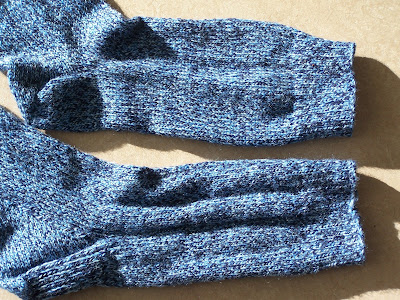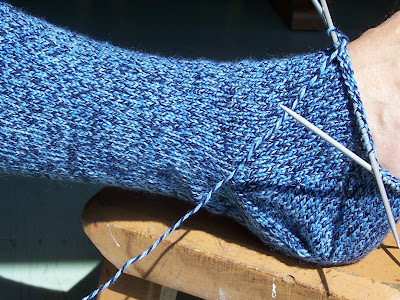I bought this yarn imagining whipping up a couple of pairs of socks for My Beloved and Number One Son. At a heavier weight than the fingering yarn I'd been using for socks up to that point I had visions of making a pair in a few hours. At the mid point in the summer I decided it was time for the "speed" socks, grabbed the yarn and the 3mm dpn's (Huge by sock standards right? These babies were practically going to knit themselves!), dutifully did a gauge swatch, cast on and in a flash produced this monster...

It looks like it was knit for someone with cloven hooves rather than feet. The heel is huge, and cardboard stiff, the instep, miles too wide, I had to reduce it for about 4" to get down to something that would be suitable at the toe which then had to be done using a precipitous rate of decreases so the foot wouldn't be miles long. To really clearly illustrate, here it is beside one that was done for the same foot but this time correctly...
 What went wrong? I followed the same "recipe" from my standard sockulator pattern AND I DID A GAUGE SWATCH! Isn't the whole world of knitting supposed to be a perfect yarny place as long as gauge swatches are dutifully produced and considered? Apparently not.
What went wrong? I followed the same "recipe" from my standard sockulator pattern AND I DID A GAUGE SWATCH! Isn't the whole world of knitting supposed to be a perfect yarny place as long as gauge swatches are dutifully produced and considered? Apparently not.Apparently a knitter has to also consider the yarn in just slightly more robust terms than potential speed for finishing a garment. Who knew? (Clearly no one around here!) How bulky the yarn was should have been part of my equation - this is clearly illustrated in the heels. First the sock suitable only for someone with feet like Mr. Tumnus'. My standard slip stitch heel, done in this yarn is just too thick. A shoe can't contain it and it won't conform to the curves of a (human wearer's) heel.
 Contrast this with the nicely behaved knit heel below. I should have also understood that with such a thick yarn, the extra bulk of the other heel to guard against wear is likely not as necessary either.
Contrast this with the nicely behaved knit heel below. I should have also understood that with such a thick yarn, the extra bulk of the other heel to guard against wear is likely not as necessary either.
 The most obvious thing I omitted to consider of course is ease. The lower sock in the shot above was the first I knit. I had a rib detail to keep the socks up. It worked with fingering weight yarn in the work socks I made last spring but the heavier yarn in this case has so much knitted bulk, even ribbing won't keep it tight to the leg just above the ankle. The whole lower leg, heel and ankle swim around. (There's a good inch of excess fabric hanging off the ankle pictured below in the progress shot I took back in August.)
The most obvious thing I omitted to consider of course is ease. The lower sock in the shot above was the first I knit. I had a rib detail to keep the socks up. It worked with fingering weight yarn in the work socks I made last spring but the heavier yarn in this case has so much knitted bulk, even ribbing won't keep it tight to the leg just above the ankle. The whole lower leg, heel and ankle swim around. (There's a good inch of excess fabric hanging off the ankle pictured below in the progress shot I took back in August.)
The astute among you will notice that despite this clear evidence things were going sideways I was not deterred and kept on going. After all I had a gauge swatch AND and proven pattern, I was confident it would all work out in the end. Does the toe on the left below look like something that "worked out?"


Well things may not have worked out for that sock but as you can see above I've now done one that has overcome the issues I had with that first one. And I've learned some great lessons from this little fiasco...
- Yarns have their own attributes that can strongly influence garment shape and behaviour
- Adding a little shaping to the leg of a sock - even a short sock isn't even a bit difficult. If I can bother to test for gauge I should take time to add a few stitches/reduce a bit to make the thing fit!
- Perhaps most valuable is that I now know gauge swatches are not akin to "immunity" on TV show contests. They do not guard against any and all potential problems. I won't put blind faith in them to make all things right ever again.
2 comments:
Your problem sock looks exactly like a problem sock I had when I made "man" socks last summer/fall. Giant heel, funny toe, just plain wrong. lol I finally got mine worked out like you did. Your success sock looks great! I love the color/yarn too.
Have a great week! :o }
LOL. I just want to know what the yarn was so I can avoid it at all costs.
PS, I am trying a different ID today. Hope that helps with eh replies.
Post a Comment